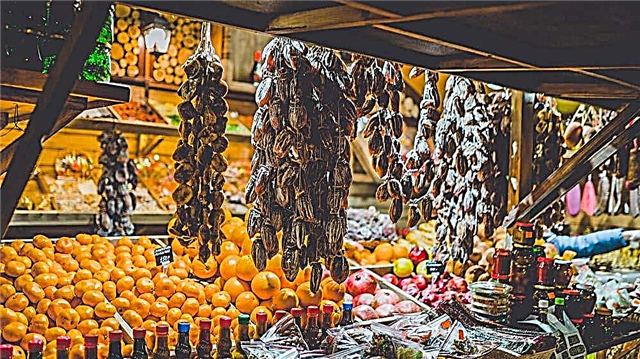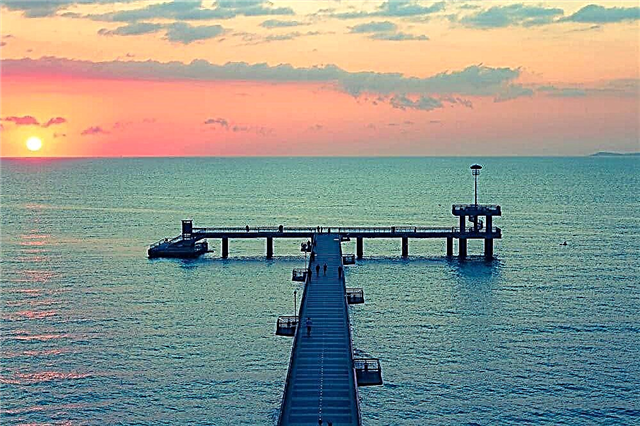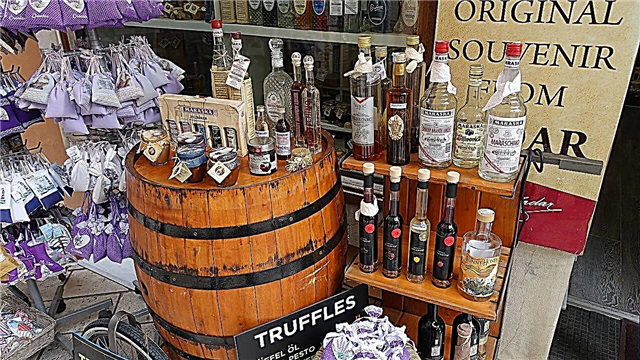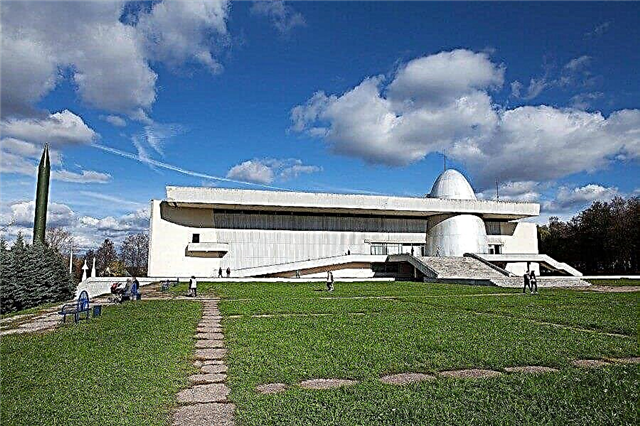Like most of the central regions of Russia, Kaluga and its environs are ready to offer tourists a wide range of attractions. For people, more or less dedicated, this region is associated primarily with astronautics. In addition, there is a typical set of museums: local history and art, as well as a couple of unique ones, including private ones.
Natural features will not leave indifferent fans of ecotourism: there are lakes, caves, reserves, all kinds of park areas. Pilgrims will not ignore the local religious buildings: rich history is superimposed on architectural beauty. The Kaluga Region is ready to satisfy the tastes of a wide variety of guests, as there are plenty of interesting objects here.
The most interesting and beautiful places in the region
What to see and where to go? List of the best objects of tourism and active recreation!
Museum of the History of Cosmonautics named after K.E. Tsiolkovsky
Located in Kaluga. Founded in 1961. The first stone was laid by Yuri Gagarin. The exposition tells about the history of Russian cosmonautics and the legacy of Tsiolkovsky. The collection is vast and numerous; it includes a model of the Mir orbital station, as well as the original Vostok. Research work is carried out in the museum, and events related to specialized topics are held.

Optina Hermitage
Monastery for men. Located near Kozelsk. It has existed since the 15th century. Named after the founder - a robber who repented and took monastic vows. After the revolution, the territory was recognized as a historical monument. Later there was a rest house and a military unit. One of the first objects returned to the Russian Orthodox Church, this happened in 1987. It took only a few years to restore the original appearance of the monastery.

Ugra National Park
It is located in the valley of the river of the same name. Founded in 1997. The area exceeds 98 thousand hectares. Divided into three separate areas and three clusters. It is a UNESCO Biosphere Reserve. It is used as a tourist destination even before obtaining official status, water routes are especially popular, since here, in addition to the Ugra, the Zhizdra, Vysa and Oka flow. Part of the territory is under state protection.

Devil's settlement
Located near Kozelsk. The tract is famous for its hill, on the top of which there is a sandstone outlet - an uncharacteristic feature for this climate. Another distinctive feature is rare species of moss and fern. Popular beliefs are connected with the settlement. Some attribute the healing properties of the water collected in the "Devil's Well" located here - a boulder in the shape of a bowl.

Tourist complex "Ethnomir"
Located in the village of Petrovo. Has been working since 2008. On the territory of 90 hectares, 52 ethnic yards are collected. They talk about the diversity of our planet. Different cultures and nationalities coexist side by side. In addition to the exposition and buildings directly related to the excursion program, there is a hotel, a restaurant serving dishes from many world cuisines. Master classes are held. There is a gift shop.

Museum-reserve "Linen Factory"
Located in the Dzerzhinsky district. Opened since 1999. It is a branch of the local history museum. A unique manor-factory architectural ensemble was formed here: two manufactories were located in the immediate vicinity of the master's houses. The exposition occupies 14 rooms. In each, the original setting has been recreated. The tour touches on the vast park and the boat station that is still in operation.

Lake Lompad
Located in Lyudinovo. In many respects (purity, depth, volume of water) is the main thing in the region. This artificial reservoir was formed on the Nepolod River. The area is about 8.7 km², the maximum depth is 16 meters. A great place for fishing and recreation. There is a promenade and beaches. There is a rental base for boats, swimming places are equipped. Competitions are held here.

Bird Park "Sparrows"
It is located in the Zhukovsky district. Opened since 2005. It was originally a private collection of birds. When the owners of the birds bought the lands of the former state farm, they brought the pets here. The number of birds is constantly increasing. Now there are about 300 species of them: parrots, peacocks, pelicans, pigeons, ducks, cranes and others. There is an ostrich farm nearby, as well as a mini-zoo, where some of the animals can be picked up and fed.

Rainbow waterfall
Located on the border of the Moscow and Kaluga regions on the Nara River. Height - 5 meters. It flows from a karst source, not wide. Nearby there is a cascade of springs, which makes the waterfall unusual and complements the water ensemble. The steep slopes of the local hills are suitable for mountaineering training. There are routes of varying difficulty, including for completely unprepared tourists.

Pafnutyev-Borovsky Monastery
Male. Located in Borovsk. Founded in 1444. The original wooden buildings were replaced with stone ones, and monastery walls appeared. The preserved shrines are the relics of Paphnutius, who founded the monastery. After the return of the Russian Orthodox Church, the iconostasis was restored, two churches were rebuilt, and the border was built in memory of the founder. Of the original bells of the monastery, only one has survived, and that one is not used, but is kept in the museum.

Art Park "Nikola-Lenivets"
Located next to the village of the same name. Opened in 2010. An architectural festival is held regularly, as well as a New Media Night. The original owner and mastermind stopped working on the project, but some of the entrepreneurs working here have stayed and hope to revive the project on its former scale. The tourist infrastructure (hostel, cafe, transport rental, etc.) is well developed and modern, but partially mothballed.

House-Museum named after K. Founded in 1936. Here the scientist lived and worked. His connection with home stretched for almost 30 years. The exhibitions were initially methodical in nature. After the war, renovations were carried out and the focus on the subject of the exposition changed. The museum began to exhibit Tsiolkovsky's personal belongings, as well as everything that was associated with his projects, albeit implemented after the death of the researcher.House-Museum of Paustovsky in Tarusa
Opened in 2012. The only museum in the country dedicated to Paustovsky. Ten years of life were associated with the writer's house. He was buried nearby, which he himself wanted and indicated in his will. Inside, the atmosphere of the 60s of the last century has been preserved. The exposition includes the personal belongings of the writer, as well as everything that was memorable and important for him that was collected. You can visit the garden and the gazebo without booking a tour.

House-Museum of Tsvetaevs in Tarusa
Opened in 1992. The museum is dedicated not only to Tsvetaeva herself, but to her entire family, because they also contributed to Russian culture. Collected things from the Moscow apartment where the poetess was born, diaries, first editions, souvenirs, etc. The exposition is divided into separate sectors: either by periods or by activity (whichever is more important). A monument to Tsvetaeva was unveiled nearby in 2006.

Kaluga Regional Museum of Local Lore
Founded in 1897. The first exhibits related to archaeological finds: parts of dishes, old coins, amulets, etc. The collection was gradually replenished, and now it is about 100 thousand units in the main fund. There are permanent exhibitions: "Philately", "Tree", "Arms", "Ethnomology" and so on. There is a rich archive with rare books and documents.

Kaluga Regional Art Museum
Founded in 1917. The first exhibits were objects of art from the collection of the local physician Vasiliev. They began to actively replenish the exhibition thanks to those nationalized from wealthy estates.In 1969, the museum acquired a new building - the former home of the wealthy Bilibin-Chistokletov family. The most valuable exhibits are icons. In addition, the exposition includes graphics and paintings of the 16th-19th centuries.

Kaluga Regional Drama Theater
Founded in 1777. It is one of the oldest in Russia. He went through a change of registration, a big fire and many internal upheavals. The performance on the stage of the theater by Maria Savina is considered significant. In the modern troupe of the theater there are both honored and people's artists of the country. In the repertoire, classical performances side by side with innovative, musicals and other experiments.

Stone bridge in Kaluga
The oldest viaduct in the country. The building dates back to 1785. Passes through the Berezuisky ravine. Length - 160 meters, width - 14 meters. It consists of fifteen stone arches, three of which are two-storey in the middle. The ravine was reinforced to prevent landslides and structural collapse. The repairs are carried out almost on an ongoing basis, but they try to make it as inconspicuous as possible, since they do not close the bridge for walking.

Church of Cosmas and Damian
Located in Kaluga. It was built around the 18th century. The architecture differs from the accepted canons of the region. The church is high and light, it consists of four semicircles interconnected. It has five domes. The bell tower stands separately. The most famous icon of the temple is Passion. The saints after whom the church is named are considered patrons of studies.

Trinity Cathedral in Kaluga
Built at the turn of the 18th-19th centuries. The plan of the cathedral repeats the scheme of the Latin cross, and its architecture belongs to classicism. If the exterior design did not change and was restored according to the available materials about the original, then the interior decoration after modern painting became darker and richer in terms of elements of church decor. The multi-tiered gilded iconostasis appeared in the cathedral in 2001.

Cathedral of Peter and Paul in Tarusa
It stands fifty meters from the bank of the Oka. Founded in 1785. Replaced the old wooden church located on this site. After the revolution, the house of pioneers was located here. The original iconostasis was replaced almost immediately for unknown reasons. Subsequently, two limits appeared in the cathedral. The transfer of the ROC after the collapse of the Union dragged on: the cathedral reopened only in 1998.

Kaluga Zaseki
A nature reserve of national importance is located in the southeast of the region. Founded in 1992. The area exceeds 18.5 thousand hectares. It is divided into two zones: north and south. The latter is almost twice as large. There are 20 rivers and large streams on the territory. The fauna is represented very widely, only mammals are more than 50 species. The diversity of butterflies is especially noted - 450 species.

Koltsovsky caves
They are located next to the village of the same name. These catacombs were carefully studied, and were also used to extract useful materials that were used for construction. Fans of mysticism and legends associate the caves with Count Vorontsov, who, according to legend, was engaged in mystical things. One of the halls of the caves is called "Khata Khan". Its walls depict the work of stonecutters.

Chernoostrovsky monastery
Female. Located in the town of Maloyaroslavets. It was founded around the XIV century, but historians have no exact data. Stands on the high bank of the Luzha River. The monastery went through ruin, even closed due to lack of funding. In the XIX, it regained its status, thanks to patrons from the merchant sphere. Restoration work began in 1991 and lasted until the end of the 2000s. Now there is a girls' shelter at the monastery.

Tikhonov Assumption Hermitage
Monastery for men. Founded in 1485. Located in the national park. There is a version that it was built on the site of the famous "standing on the Ugra". After the revolution, the building was given to a military unit. In 1991 it was returned to the Russian Orthodox Church along with the surrounding lands. In 2017, the country's first monument to Ivan III was unveiled nearby. The monastery has a Sunday school and a small publishing house.

Shamordinsky monastery
Female. Located next to the village of the same name. Optina Pustyn is located only 12 kilometers away. The dawn of the monastery fell on the beginning of the last century, but was short-lived. The revival began in 1990. The first to illuminate the temple in honor of the icon "Soothe my sorrows" In addition to it, there is another temple, a cathedral, a refectory, a hospital, and outbuildings on the territory.

Spas-na-Ugra
Convent. It was first mentioned in chronicles in 1511. It was abolished 250 years later, and restored in 2007. The two temples of the monastery have different architecture from each other. Preobrazhensky is an example of the tent style. In addition, the church has survived, the rest of the buildings were wooden, so they have already been lost. The reconstruction even concerned the vaults of the temples and the roofs, damaged by time.

Museum "Zaitseva Gora"
Located in the village of the same name. Founded in 1972. Has a military-historical focus. In 2014, the exposition was significantly modified. It is dedicated to the exploits of the heroes of the Second World War. Each mini-exhibition tells about a specific battle, resistance, organization of an offensive or the life of areas during the occupation. Authentic guns are installed nearby. There is a hotel nearby.

Private Museum of Sergei Zharov
Located in the founder's house in Tarusa. Open every day, guided tours for groups. The collection consists of both rare items of the past and crafts of the owner himself. In the house you can find more than a hundred old and foreign irons. There are also kerosene lamps, sewing machines, rare photos. In the courtyard and in the garden there is a separate exhibition of sculptures and much more.

Museum of Strategic Missile Forces in Balabanovo
Has been working since 2004. A collection of a similar museum from Vlasikha was transported here. The exposition includes, among other things, 20 real ballistic missiles, some ten years ago were hidden under the heading "secret". They are housed in a high hangar at the military academy training center. Next to the building is the original, but decommissioned "Topol". Visiting is possible in groups by appointment.












